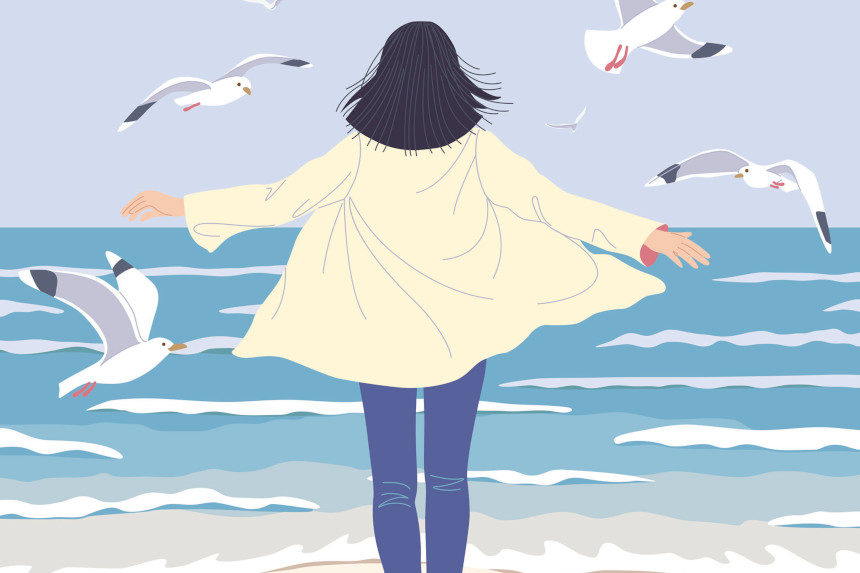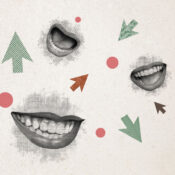Pedestrian: a word fitted to the most drab, tedious, and monotonous moments of life. We don’t want to live pedestrian lives. Yet maybe we should. Many of history’s great thinkers have been pedestrians. Henry David Thoreau and William Wordsworth, Samuel Taylor Coleridge and Walt Whitman, Friedrich Nietzsche and Virginia Woolf, Arthur Rimbaud, Mahatma Gandhi, William James — all were writers who hinged the working of their minds to the steady movement of their feet. They felt the need to get up and get the blood moving, leaving the page to put on a hat and go outside for a stroll. In doing so, they were in step with the antipodal forces of motion and rest, an impetus written into the laws of nature.
How many of us today are able to free ourselves from the page and head out the door when we rise from our desks? Even abiding by the dictates of nature, breathing deeply out in the open air as we set our legs into motion, it’s likely we need to accomplish the undertaking as quickly and efficiently as possible. But in so doing, perhaps we still miss the essence of the activity itself. We forgo the art of walking.
“Walking with a purpose” is usually regarded as a positive thing, taken as a sign that people are focused, with eyes on an end goal or prize. But the art of walking is not about purpose or aim. As Immanuel Kant maintained, the creation and apprehension of beauty is embodied in “a purposiveness without a definite purpose.” The art of walking is all about this purposeless purpose.
These days, it’s difficult to understand the point of doing something, or doing anything, without an underlying aim. We typically walk in order to get somewhere: the grocery store, the yoga studio, the water cooler. We need to walk the dog, or we walk in protest for a cause. We walk to get in shape, tallying up our steps on a Fitbit or smartwatch. Perambulation becomes a matter of proving, achieving, gaining, winning, meeting a concrete objective. There is something both funny and sad about orienting our walking exclusively around such discrete ends. The frantic attempt to get somewhere, and to be on time about it, amounts to a Sisyphean struggle against the clock: When we reach a destination, we must immediately set off again, intent on the next stopping place. The point of the journey is no more than to “get there.” Moving our feet is just the drudgery endured between moments of rest.
Walking, simply for the sake of a walk, can be a brief respite in our otherwise frenetic lives.
Walking is increasingly mediated by technological gadgets worn on wrists or gripped in hands. We spend an increasing amount of time “screening” the world — taking in most of life through a contracted frame that captures objects of immediate interest. To live with eyes on the screen is to be attached, stuck in the frame, taking in what is presented to us and re-presented to us again. But representation even in fine-grained pixelation is not experience. To experience is to perceive. When we look at a screen, we might see something, but we don’t perceive. To live life through representations is to live passively, to receive rather than to experience. It is also, we fear, to live the life of a follower. Instead of asking What do I see? How might I tell you? we are told instead how to see, and often what to feel — much of which is determined by algorithm.
The art of walking is antithetical to “screening” the world we live in, and there is no preprogrammed set of rules or calculations involved. Walking, simply for the sake of a walk, can be a brief respite in our otherwise frenetic lives, allowing us to detach so we might see life for ourselves again, not unlike a child does. This, according to Kant, is the freedom of any form of art. But we don’t need to visit a museum in order to be absorbed in artful perception and contemplation. We can just step out the front door, pay attention, and perceive and feel for ourselves.
The discipline of walking as it relates to art should not be mistaken for a leisure activity. Take, for example, walking as a flâneur, or as a pilgrim, or going out for a promenade, for in each of these pursuits there are goals: The flâneur sets out into the city streets to investigate or procrastinate; the pilgrim ambles toward the holy land for the sake of a blessing; an evening stroller seeks digestive benefits as well as social interaction, whether walking with a companion or encountering neighbors along the road. In all cases, there are ends to be gained.
Artists allow us to peer into the world through their eyes. Walking as an artist gives us this rare opportunity too. We might be detached while at the same time fully engaged as we move along. The mind is no longer in a state of intention — gathering facts or supplies or blessings, burning calories, being seen — but is instead in a state of attention. The activity becomes a temporary renunciation of purpose and is its own reward, like a form of art: that which Kant referred to as a good in itself. There is a certain beauty in the awareness of being fully alive while striding through a given space in a given time. This cannot be gotten at through a page or a screen, but only through ears and eyes and nose and skin: the sensation of sky and light, of a building’s grace or immensity, of waves and wind, rocks and leaves, a boundless horizon. When we peer through a screen, we cut off these sensations, limiting too the promenade of thoughts going by — our own insights and visions, not someone else’s.
Walking with disinterest requires a little effort in the beginning, and it comes with practice. Take, for example, a route that we normally walk on our way to work. Our goal is to get there safely and on time, as efficiently as possible, maybe checking email midstride or stuffing earbuds into ears to drown out the traffic or the street life. We move purposefully, with a practical interest in mind. But let’s say, instead, we walk the same path on a day when we don’t need to be at work. We opt to leave the smartphone at home. We decide to slow down and let the mind wander in the open expanse before us. We use the time afoot as Woolf would do, as an opportunity and space in which “to spread [the] mind out.”
Still, someone might say, what is the point of simply meandering? This would be like asking what the point of watching a sunset is, or asking the value of gazing at a Rembrandt, or smelling a rose. The answer is simple: for the experience alone. The point is to perceive. Nothing more and nothing less than this. A genuinely aesthetic experience of beauty is aimless. Only when we cultivate an attitude of disinterest are we able to fully apprehend the experience. This might seem confusing, since sunsets and paintings and roses are captivating. But they don’t seize our minds with the iron grip that daily life typically exerts. Watching a golden ball dissolving into the horizon is not going to add to our bank accounts or social status. Our instrumental ends usually force us to see and understand the world in parts, in fragments that fit our particular purposes. In art we are returned to a more expansive world. Happily, we can travel through this world by walking, with an attitude of detachment, in a state of awareness, attention. We can behold, rather than be held.
When we give ourselves over to the art of walking, we exist in the moment for no reason or purpose other than that of the experience alone, for the appreciation and apprehension of beauty. There is no purpose in this occurrence, only the immeasurable effect it has on our nerves, our body, our being. Woe the society that sees little or no value in this.
John Kaag is a professor of philosophy at the University of Massachusetts, Lowell, and the author of Sick Souls, Healthy Minds: How William James Can Save Your Life (2018). Susan Froderberg is the author of the novels Old Border Road (2010) and Mysterium (2018).
This article was originally published at Aeon and has been republished under Creative Commons.
This article is featured in the May/June 2021 issue of The Saturday Evening Post. Subscribe to the magazine for more art, inspiring stories, fiction, humor, and features from our archives.
Featured image: Shutterstock
Become a Saturday Evening Post member and enjoy unlimited access. Subscribe now




Comments
In our residential development, it’s exactly one mile to ride or walk completely around it. Moreover, in one direction it’s uphill; in the opposite direction it’s downhill. Plus, the uphill direction is north; meaning that when a good stiff wind is blowing, usually from the north, northwest, or west, that adds to the effort. We never have to go out on the busy secondary roads: An hour or more strolling the neighborhood three or four days a week is just fine for us 60-plussers.
For most of my adult life age 30-69 years, I mostly worked from a sitting position. Exercise consisted of swimming and cycling when time permitted. Walking was a means to transverse the space between my car and a desk or store.
Upon retiring, while in pretty good shape for those 2 activities, I began to notice my walking was suddenly strained. Not as unconsciously effortless as it once was. I began again to explore and enjoy the pleasure of walking simply to assure I didnt loose the ability. An ability many take for granted till its gone.
It has been a pleasure to rediscover this ancient pleasure. To add it back into my weekly exercise routines.
Its never too late.
Personally I leave the smart phone at home when I go on walks. It’s nice to be able to connect with images, scents and sounds aside from all the electronics we’re largely attached at the hip to. It’s not ‘our fault’ up to a point, but beyond that it is if we don’t have a consciousness of the importance of disconnecting from it.
People walking dogs while on their cell phones are often depriving themselves and their dogs of an enriching experience for both. For the person they’re tuned out to what the dog is experiencing through his or her sense of smell by often rushing their pet along. Smelling is what makes that walk like a trip to Disneyland for their dog.
You can’t stay in one spot forever, but a couple of minutes is reasonable. With most spots the dog will just move on after a brief sniff anyway. For those in tune with this the experience can be therapeutic for both pet and parent, helping both feel calmer once home again. A little meandering means a lot, especially in these awful times.